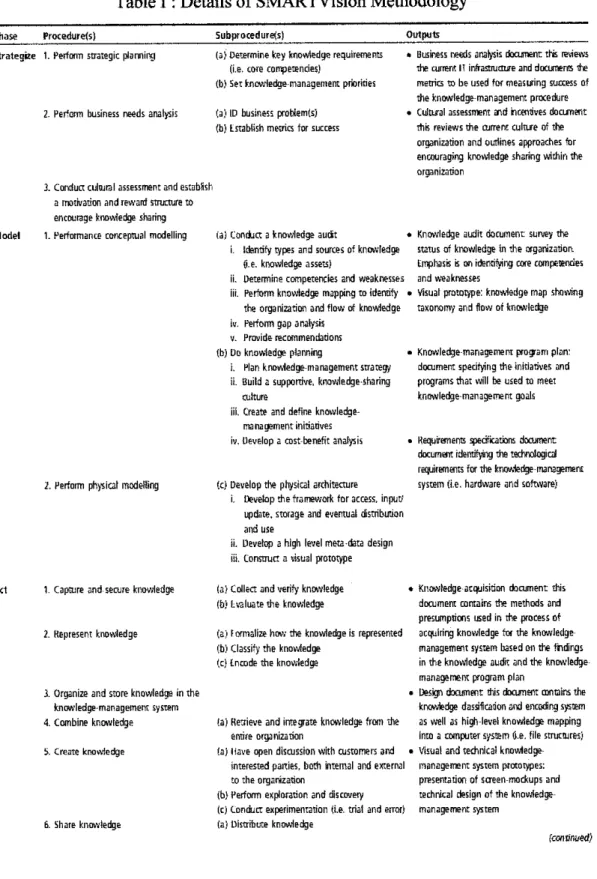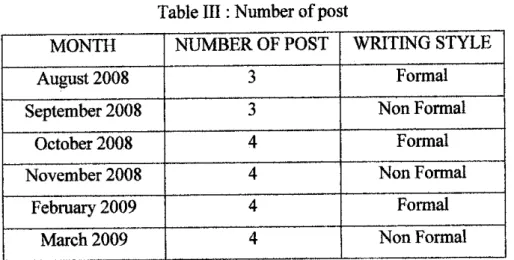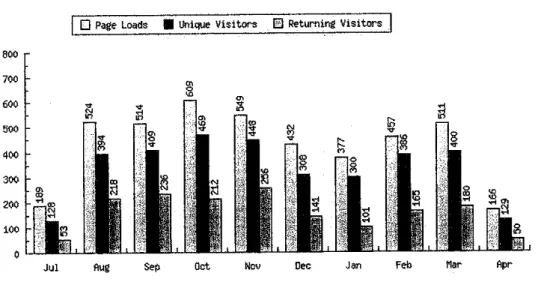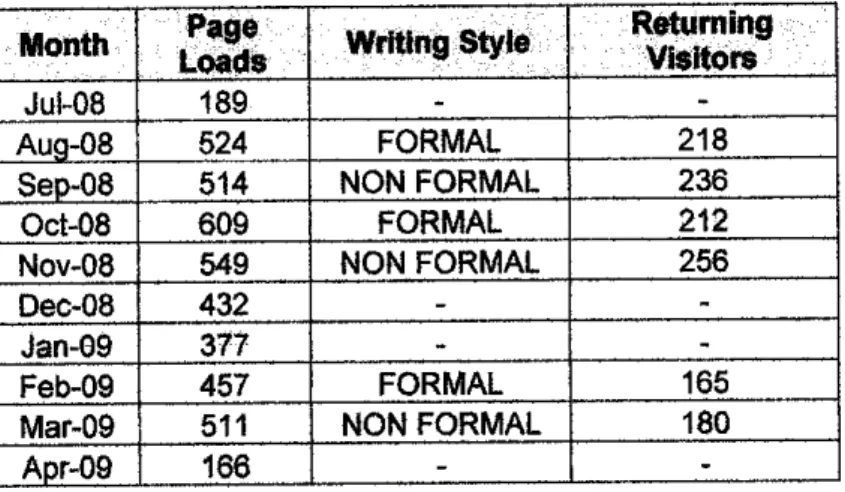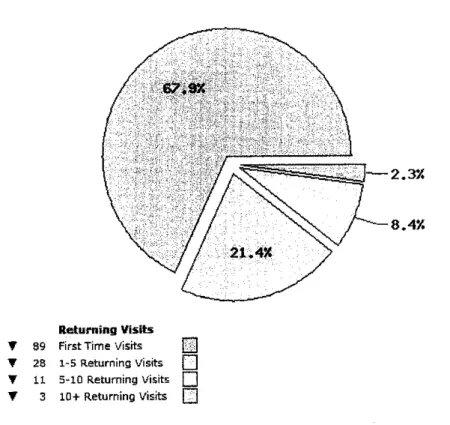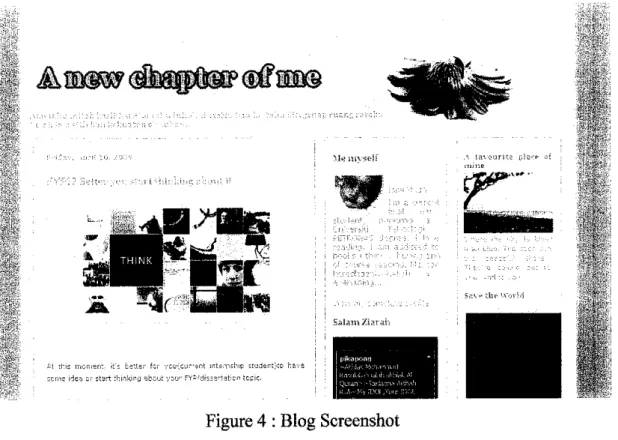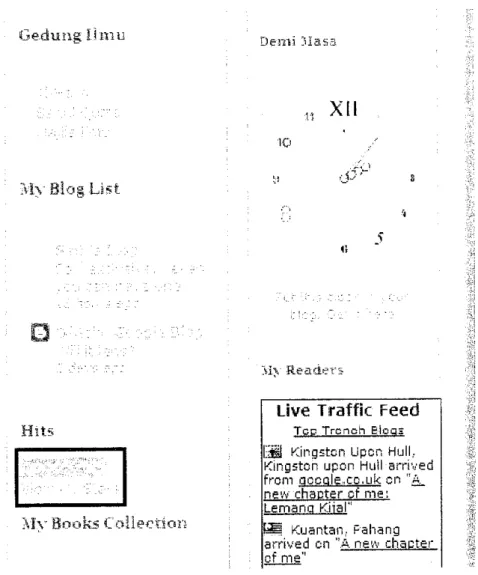Writing Style Impact in the Success of Knowledge Sharing Through Blog
by
Nor Huda Bt Mazan
Dissertation submitted in partial fulfilment of the requirements for the
Bachelor of Technology (Hons) (Business Information System)
JANUARY 2009
Universiti Teknologi PETRONAS
Bandar Seri Iskandar 31750Tronoh
Perak Darul Ridzuan
CERTIFICATION OF APPROVAL
Writing Style Impact in the Success of Knowledge Sharing Through Blog
by
Nor Huda bt Mazan
A project dissertation submitted to the Business Informatin System Programme
Universiti Teknologi PETRONAS in partial fulfilment of the requirement for the
BACHELOR OF TECHNOLOGY (Hons) (BUSINESS INFORMATION SYSTEM)
Approved by,
1 7~^
(Mazeyanti Binti Mohd Ariffin)
UNIVERSITI TEKNOLOGI PETRONAS
TRONOH, PERAK January 2009
CERTIFICATION OF ORIGINALITY
This is to certify that I am responsible for the work submitted in this project, that the original work is my own except as specified in the references and acknowledgements, and that the original work contained herein have not been
undertaken or done by unspecified sources or persons.
^ 1
NOR HUDA BT MAZAN
ABSTRACT
Weblogs, or blogs, have been a significant new development in recent years.
The emergence of corporate and academic blogs are great effort for knowledge sharing. But how success these blog in attracting users to read through the blog posts in promoting sharing of knowledge? This project aims at investigating the role of writing style factors in the success of knowledge sharing through blog.
The project also aims to promote knowledge sharing culture people by providing them with a blog as a medium for communication and knowledge transfer. The first part of the paper deals with hypothesis that will be developed and this hypothesis will be proved by creating two way of writing style which is formal and non formal. The second part shows the results of the analysis on user participation to these kind of writing style that allows us to better understand the role of writing style. The conclusions of this study are based on interpreting the hypothesis that have been proven by the analysis. The research findings indicate that non-formal writing style positively related to user participation through blog.
m
ACKNOWLEDGEMENT
This thesis could not successful without the help of many people, I would like to thank all UTP lecturers for providing me knowledge and skills which served as a strong background in completing this project. My specials thanks go to my supervisor Ms.
Mazeyanti Mohd Ariffin for her supervision and support. Her positive criticism and useful advice are the motivation to carry this work into a finished system. My friends and colleagues deserve many thanks for their help and supports. I would like also to thank my parents, for the support and encouragement both during work and in all my
endeavours.
IV
TABLE OF CONTENTS
CERTIFICATION i
ABSTRACT hi
ACKNOWLEDGEMENT iv
CHAPTER 1: INTRODUCTION 1
1.1 Background of Study 1
1.2 Problem Statement 2
1.3 Objectives and Scope of Study 3
CHAPTER 2: LITERATURE REVIEW 4
2.1 Social Network 4
2.2 Blog WritingStyle 6
CHAPTER3: METHODOLOGY 7
3.1 Project Methodology 7
3.2 Research Methodology 11
CHAPTER 4: RESULTS AND DISCUSSION 13
4.1 Data Gathering & Analysis 13
4.2 Prototype 16
CHAPTER 5: CONCLUSION AND RECOMMENDATION 18
5.1 Conclusion 18
5.2 Recommendations 18
REFERENCES 19
CHAPTER 1 INTRODUCTION
1.1 Background Of Study
Nowadays people obtain lots of information through surfing the internet besides through other materials such as newspaper and magazines. The emergence of various social network such as Facebook, Friendster and Blog plays important roles in knowledge sharing among internet users. Furthermore we can find communities which share the same interests with us to share and get the knowledge by using these kind of social networks. Among these, blogging is becoming a great tool and has become trend nowadays. Blogging has been a popular public activity for several years, andhas attracted many users from different background of study and life style.
Two blogs are allegedly created every second in the world (Technorati, www.technorati.com). According to the same source, between December 2004 and December 2006, the number of blogs in the world rose from 5.4 million to 63.1 million. Thus, the "blogosphere" saw its size multipliedby 11 in 2 years.
Moyes (2006) noted that according to New Research from Microsoft MSN portal, about 46% or nearly half of those online in Asia have a blog, 41% spend more than three hours a week blogging and 50% believe blog content to be as trustworthy as traditional media. This study was conducted online, covering its seven markets in Asia, namely Hong Kong, India, Korea, Malaysia, Singapore, Taiwan and Thailand.
The sample size was over 25000. Some key findings on this research is over 74% of bloggers in Malaysia are below 25 years old.
This study reflects the blogosphere or blog trend in Malaysia. It showed that blogging is a social phenomenon as a means to maintain and build their social connections and to express themselves. It also reflects that people nowadays see blog as a user-friendly tools rather than other service such as forum and so on.
However, how success the blog o contribute in knowledge sharing is the question that needs to be analyzed. The number of blog created does not really matter if the blog itselffail to attract many users to participate or interact through it. It is because
blog's success is partially dependent on the readers' loyalties to it. The number of
readers who give comments also show a good indicator of thesuccessful blog.There are some factors that contribute to the popularity of blog such as the visual and audio content but for this project the focus is on the writing style. For this project, it becomes one of the main objectives to develop a social networking which is blog.
The main target reader for this blog is for Universiti Teknologi Petronas student itself
and Malaysian for general readers.
1.2 Problem Statement
A high level of participation was a prerequisite to the blog's success. It shows the number of people did share the knowledge through it. There are million of blogs has been created but not many of them attract many user to participate into that. Why?
There are some factors that contribute to the popularity of blog but for this project the focus is on the writing and style chosen. Did writing style through blog affect user intentions to participate and share information or knowledge?
There are also many corporate blog has emerged such as Google Blog (http://googleblog.blogspot.com/), HP Blog (http://www.communities.hp.com/), Agilent (http://nano.tm.agilent.com/blog/) and etc. Besides, the academic blog also growing exponentially such as Harvard University Blog (http://harvardpress.typepad.com/), Nursing Board Exam Blog (http://phiiippinesnursingboardexamsanswerkey.blogspot.com/), IE Student Blog (http://ie-student.blogspot.com/), and so on. These blog purposely develop by the author to exchange information to their customer and readers. It is great effort in promoting knowledge sharing but the question is how success these blog in attracting users to read through the blog posts? How many comments do they received? There are some factors that contribute to this situation and one of them is the way the
author write the blog entries. The factor of formal and non-formal writing style do affect user participation to the blog entries.
1.2.2 Significant of the Project
The research project can greatly encourage and guide people on using the right writing style in blog as one of the way to promote knowledge sharing. The blog that has been developed actually creating a 'conducive' environment or platform for people to share withthe hope of increase in knowledge behaviour among people. By proposing the hypothesis whether there is a difference on userparticipation by using formal or non-formal writing style are actually provides additional value to bloggers (personal or corporate blog)
1.3 Objectives and Scope of Study 1.3.1 Objectives
1) To develop a blog.
2) To proof writing style impact on user participation through blog.
CHAPTER 2
LITERATURE REVIEW
2.1 Social Networks
2.1.1 Definition of Social Network
"Social networks are a social structure of nodes that represent individuals (or organizations) and the relationship between them within a certain domain. Therefore, social networks are usually built based on the strength of relationships and trust between members" (Liccardi et al, 2004).
Phillips (1996, p. 4) point out that a social network can be defined as a group of social actors that interrelate or exchange information with one another. The study of a social network that exchanges information between and among its members provides interesting insights into howknowledge is spread throughout a community
Social networks such as Facebook, MySpace, Blog are useful and beneficial when finding people on the Internet with whom you are likely to have interesting and useful conversations. To make sure that people can represent their identity and to allow people with mutual or same interests to find each other, social networking systems have been created.
2.1.2 Social Network and Knowledge Sharing
A recent study (Matthys et al, 2006) state that passive knowledge sharing should be complemented with interactive knowledge sharing approaches and that the social networking paradigm is well suitedto allowthis.
4
Another element that suggested by the same author for social network in contribution to knowledge sharing is the group space contains tools, which allow knowledge sharing between multiple people. This space constitutes the overlap between the areas of knowledge management, social networking systems and community informatics. In most systems, the tools, which are available in the group space, are limited to a forum on which members can post and read messages. There is still much room for improvement in the group space, as it exists in current social networking systems, in order to better support knowledge sharing between multiple
people.
The idea of social networking within the corporate frame is about knowledge sharing and knowledge management. (Razbaeva 2007)
2.13 Social Network: Blog as a great tool
Social networking is become a trend and important nowadays. The emergence of corporate Blogs creates new opportunity for companies to interact withcustomers as
one of the advantage. Some reasons for choosing blog as a tool for this project is the
user involvement through blogging.
Corporate Blogging fundamentally enables atwo-way communication between an organization and its customers. Through Blogs, it is much easier for a company to seek opinions, participations, and knowledge from its consumers. In fact, the challenge for most companies is not how to obtain feedback; but how to best deal
with the feedback (Chen, Liu & Hu, p.6153)
A blog (derived from web log) is an online journalthat contains newsand views on a particular subject or acts as the owner's personal diary. Most blogs give readers the ability to comment and discuss the issues raised by the owner. (Payne 2008)
Razbaeva (2007) stated that on the business side many companies also started to recognize the benefits that social networking can bring to the workplace e.g. blogs or wikis. It encourages collaboration and efficiency both internally between co-workers and externally with customers and partners.( http://blog.isn.ch/)
For an instance, GM has adopted FastLane Blog (http://fastlane.gmBlogs.com/) to
spread news, provide information, and create an online community where its
customers can exchange information anddiscuss what is important to them. Anotherexample, Microsoft developers and product managers are talking directly to customers daily via Blogs to understand how customers respond to Microsoft products and services. There are also thousand ofcompany nowadays are using blog
to communicate and share the knowledge with their customer.
2.2 Blog Writing Style
2.1.1 Definition of Writing Style
A blog is a web site, where anybody can write about his or her own personal experiences and thoughts on a voluntary basis. As a result, it reflects user's personality and cultural biases, sometimes user will attract to the blog because ofthe
way the writers express the ideas.
Writing style is the manner in which a writer addresses a matter in prose. A style reveals the writer's personality or 'voice.' It is the result of the choices the writer makes in syntactical structures, diction, and figures of thought. Similar questions of
style exist in the choice of spoken language, (www.wikipedia.com)Literary style is defined as the characteristic manner in which an author expresses
him- or her-self. The single most important thing to note about great writers is that their style is unique, different and idiosyncratic. (Brown, 2009, pp. 75)CHAPTER 3
METHODOLOGY
3.1 Project Methodology: SMARTVision Knowledge Management
Methodology
Developing a KM methodology is a critical step to conduct KM activities orprojects.
Rebeck (2001) present SMARTVision Knowledge Management methodology that can be implemented in any KM activities. Figure 2 shows a high-level view of the method, and Table I lists the specific phases, procedures and outputs for the
methodology.
The SMARTVision knowledge management methodology
Figure 1:SMARTVision Knowledge Management Methodology
This methodology addresses the entire KM process and give details on how to
actually performing KM activities or projects. The methodology is cyclic, with multiple feedback loops. The cyclic, iterative of the methodology is illustrated by the
looping in Figure 2.
The diagram in Figure 2 is detailed in Table I. Specific procedure are given for each general KM phase. The outputs provide direction regarding what should actually be
completed during each phase.
Table I: Details of SMARTVision Methodology
Phase Procedure(s) 5ubprocedure(s) Outputs
Strategic 1. Perform strategic planning
2. Perform business needs analysis
(a) Determine key knowledge requirements (i.e. tore competencies!
(b) Set knowledge-management priorities (a) ID business probiem(s)
(b) IstabSish metrics for success
1 Conduct cultural assessment and establish a motivation and reward structure to encourage knowledge sharing
Model 1. Performance conceptual modelling (a) Conduct a knowledge audit <
i. Identify types and sources of knowledge (U. knowledge assets)
ii. Determine competencies and weaknesses iii. Perform knowledge mapping to identify •
the organization and flow of knowledge iv. Perform gap analysis
v. Provide recommendations
(b) Do knowledge planning •
i. Plan knowledge-management strategy ii. Build a supportive, knowledge-sharing
culture
iii. Create and define knowledge- managementinitiatives iv.Develop a cost-benefit analysis
I. Perform physical modelling
Ad 1. Capture and.secure knowledge
2. Represent knowledge
3. Organize and store knowledge in the knowledge-management system 4. Combine knowledge 5. Create knowledge
6. Share knowledge
(c) Develop the physical architecture i. Develop the framework for access, input)'
update, storageand eventual distribution and use
ii. Develop a high level metadata design iii. Construct a visual prototype (a) Collect and verify knowledge (b) Lvaluate the knowledge
fa) Formalize howthe knowledge is represented (b) Classify the knowledge
(c) tncode the knowledge
(a) Retrieve and integrate knowledge from the entire organization
(a) Have open discussion with customers and interested parties, both iiternal and external to the organization
(b) Perform exploration and discovery (c) Conductexperimentation (i.e.trial and error) (a) Distribute knowledge
Business reeds analysis document ths reviews the current IT infrastructure and documents the metrics to be used for measuring success of the knowledge-management procedure Cultural assessment and incentives document this reviews the current culture of die organization and outlines approaches for encouraging knowledge sharing within the organization
Knowledge audit document: survey the status of knowledge in the organization, tmphasis is on identifying corecompetencies and weaknesses
Visual prototype: knowledge map showing taxonomy and flow of knowledge
Knowledge-management program plan:
document specifying the initiatives and programs that will be used to meet know ledge-management goals
Requirements specifications document document identifying the technologiczi requirements for the knowledge-management system (i.e. hardware and software)
Knowledge acquisition document this document contains the methods and presumptions used in the process of acquiring knowledge for the knowledge management system basedon the fadings in the knowledge audit and the knowledge management programplan
Design document this document contains die knowledge dassification and encoding system as well as high-level knowledge mapping into a computersystem (i.s. file structures) Visual and technical knowledge- management system prototypes:
presentation of screen-mockups and technical design of the knowledge- management system
Phase Procedure^)
/. Learn knowledge and loopbackto sap 1 of this phase
Revise 1. Pilot operational use of the knowledge
management system
2. Conduct knowledge review
3. Perform knowledge-management system review
Transfer !. Publish knowledge
2. Coordinate knowledge-management activities and functions
i. Use knowledge to createvaluefor the enterprise
Subprocedurefc) Outputs
(b) Make knowledge easily accessible
(a) Perform quality control
i. Review knowledge for validity and accuracy ii. Update knowledge
(b) Perform relevance review
i. Piune knowledge andretain whatis relevant, timely andaccurate andproven useful
(a) !est and evaluate achieved results (b) Hevalidateftest againstmetrics
Lvaluation methodology and results document general evaluation and review of the KM system. Ihis document will evaluate the fitness of the developed KM system forimplementation inthe transfer phase. Critical analysis of the completed KM system, which includes tie determination of whether the program is ready fortransfer and will be completed,
and recommendations to continue development will be e/aluated "Ihe documentation of the evaluation
methodologies used for the review and the documented results of the review are required Knowledge-management systemprototype II: a pre-production, fully functional release of the KM system
User's guidefor knowledge-management system: the methods and procedures developed forthe KM system arecompiled into a guide for use as a training document and the coordination of standard practices, ihe guide should describe both internal system processes and howthe system interacts with the erwanment
(a) Creata integrated knowledge-transfer programs (b)Notify where knowledge is located and
lessons learned
(c) Perform serious anecdote management (i.e.
pubficize testimonial ofthe benefits of theKMS) (a) Sell (e.g. package knowledge bases forsale) (b)Apply (e.g. knowledge-management
consulting services, apply methodology) (c) Use (e.g. improve customer satisfaction,
employee supportand training)
4. Monitor knowiedge-management activities via metrics
5. Conduct post-audit
6. txpand knowledge-management initiatives
/. Continue to learn and loop backthrough the phases
Maintenance document for KM system:
following the completion of the final version of the KM system, documentation describing the general maintenance and change process forthe system arecreated Iully functional KM system: the final delivered and installed KM system Post-audit document: following the completed transfer of the KM system a follow-up audit ofdie entire process is completed, ihiswill include all lessors learned, userexperiences, besuworst practices and proposed changes to the methodology and<or KM system. The post- auditwill also indude proposals for new initiatives and enhancements for the system Lessons learned document lessons learned
and otherappropriate leamnig functions will be formatted and loaded into the appropriate corporate memory location for dissemination throughout the organization
3.2 Implementation to the Project
By choosing this method, the blog will be developed once the survey has been analyzed. Once the survey is completed, data will be aggregated and analyzed so that the blog that will be created is suited on what students and lecturers needs and requirement. The methodology will be implemented in this projects as shown in
Table II.
Table II: Details of the project methodology
PHASE PROCEDURE SUBPROCEDURE OUTPUTS
Strategies 1) Perform planning a) Determine key knowledge
requirements (i.e. no sharing medium, trust)
• Review current
final year student
conditions on
knowledge sharing
Model 1) Performance conceptual modelling
a) Conduct knowledge
audit
i) Identify type of knowledge need
for FYP students
ii) Identify trend of knowledge sharing among FYP
students.
• Knowledge audit
document:
survey
2) Perform physical modelling
a) Develop the prototype: blog
Act 1) Capture and secure knowledge
a) Collect and verify knowledge
b) Evaluate knowledge
• The statistical data that will be retrieved from the blog.
Revise 1) Conduct
knowledge review
a) Perform quality
control
i) Review knowledge for validity
ii) Update knowledge
• Content of the
blog
Transfer 1) Publish knowledge 2) Use knowledge to
create value
3) Continue to loo back through the phases
a) Prove the hypothesis b)
• Lesson learned document
(result)
10
3.3 Research Methodology
The target population of this study is the blogs of A New Chapter Of Me (http://firnass-anewchapterofme.blogspot.com/). In terms ofwriting style, the author adopted a formal/official writing style to different posts inthe blog. The information
then retrieved form the number of users participates in every single posts in the blog.
This project methodology has two parts. In the first part, the author will publish posts with different writing style which is formal and non-formal. The aim of this case study is to analyze the pattern number of users to participate (number of user,
comments from user) surfing on that blog for that post. There are 35 posts has beenpublished to the blog since July 2008 until April 2009, where the post writing style has been differentiate according to months. Table III present the number of post with
formal and non formal writing style accordingto months.
In terms of writing style, the author adopted a casual tone for blog non-formal blog
entries. The author use "chatty" style about some events, recipes and included a lot of personal observation and opinion.Table III: Number of post
MONTH NUMBER OF POST WRITING STYLE
August 2008 3 Formal
September 2008 3 Non Formal
October 2008 4 Formal
November 2008 4 Non Formal
February 2009 4 Formal
March 2009 4 Non Formal
11
In the second part, the author will carry out an analysis to proof the hypothesis that
has been suggested for this project.
The following hypothesis will be tested:
Ho: There is no difference on user participation by using formal writing style.
Hi: There is a difference on userparticipation by using non-formal writing style.
3.4 Development Tools
Here are the recommended tools for the development of this system:
3.4.1 Software
This is the list of minimum, software needed to use throughout the whole project:
• Blog service (Blogspot)
• Online survey service
• Blog Stat Counter
3.4.2 Compatible Browser
Currently, theblog display best performance onthe Microsoft Internet Explorer 6.0. and Mozilla. While on Netscape, these browsers differ in functionality, speed
and feature.
12
CHAPTER 4
RESULT AND DISCUSSION
4.1 Data gathering and analysis
The data comes from a blog A New Chapter Of Me that has been created purposely
for this project (http://fimass-anewchapterofme.blogspot.com/).The information was
taken from the information on the number of returning users to the blog, which
determine the person is returning to your website for another visit an hour or more later based purely on a cookie. This reflect the number ofsame user that returning to the blog that have been posting using different writing style for certain months. It shows the number of loyal user for the month that use two different wiriting style for
the blog.
The results of the analysis shows that the non-formal writing style post did attract more users to participate, give comments compared to formal writing style post. The
overall access rates of the non-formal post are very high. Statistics generated by theBlogsStats Counter software demonstrate that many people accessed the blog from domains inside the university while quite a big number from outside university and
several form overseas. ( Indonesia, UK, etc )
This appeared to be a successful strategy by writing with non-formal style because readers enjoyed this approach and found it more interesting to read than a more
"official" tone. Some casual posts were greatly commented on by readers.
Table 4 and Figure 2 shows the number of user attract to the blog based on three criteria (number of page loads, unique visitor and returning visitor). Returning Visitors - Based purely on a cookie, if this person is returning to your website for
another visit an hour or more later. First Time Visitors - Based purelyon a cookie, if
13
this person has no cookie then this is considered their first time at your website.
Unique Visitor - Based purely on a cookie, this is the total of the returning visitors and first time visitors - all your visitors. Page Load - The number of times your page
has been visited.
Summary (A new chapter of me)
naJJM I ttjggflr ' Monthly I Quarterly I Yearly D Page Loads • Unique Visitors El Returning Visitors
Figure 2 : Summary of number of users
Table 4 : Summary number of users according to writing style
Month Page
Loads Writing Style Returning
Visitors
Jui-08 189 - -
Aug-08 524 FORMAL 218
Sep-08 514 NON FORMAL 236
Oct-08 609 FORMAL 212
Nov-08 549 NON FORMAL 256
Dec-08 432 - _
Jan-09 377 - -
Feb-09 457 FORMAL 165
Mar-09 511 NON FORMAL 180
Apr-09 166 - -
14
Findings for this analysis is the number of returning visitor for the months implementing non formal blog post is greater than the formal blog posts. This
indicates that the same users are more actively participate and attract to the non
formal writing style to obtain and share the knowledge compared to formal writing style. This analysis proof HI that state there is a difference on user participation by using formal or non-formal writing style. User tend to be loyal the blog post that
have similar trend of non formal writing style. The same user that who knew the trend will continuously review the blogfor nextpostforthe month.
A new chapter of me {Returning Visits) 11th April 2009 04:09:48
| Your log size of 500 has 500 entries. Ask youradmin about increasing your
log size!
Returning Visits
T 89 First Time Visits j\£J T 28 1-5 Returning Visits Q V 1L 5-10 Returning Visits Q V 3 10+ Returning Visits [/j
2.33*
8.4)4
Figure 3 : Analysis on number of returningvisits
15
4.2 Prototype
The blog has been created purposely for this project with different kind of post writing style. The blog address is http://firnass-anewchapterofme.blogspot.com/.
Figure 5 show blog prototype while Figure 6 show total number of user that analysed
by BlogStatsCounter Software.
M^m\seif
Salant Ziarah
idea =:-start :1-in!<irg stsuE ysu'- ry:'di= =5Tat'cr> Stcie.
Figure 4 : Blog Screenshot
16
Geduna l\'
Iv Bios List
[its
Mv Books Collection
Demi 3Ias3
,, XII
10
,-vr
'M\ Readei
Live Traffic Feed
Teg Trench EJoqs
Edp Kingston Upon Hull,.
Kingston upon Hull arrived from aocQle„CQ,uk en "£_
new chapter cf me:
Lemang Kiial"
ES Kuantan. Pahang arrived en "A new chapter cf me"
Figure 5 : Blog Statistic Counter
17
CHAPTER 5
CONCLUSION AND RECOMMENDATION
5.1 Conclusion
In conclusion, the purpose of this study is to develop test and analyze factors that
influence users' intention to participate (sharing of knowledge) through a kind ofsocial network, which is blog. The author verified the effect of writing style on the behaviour/participation of blog users and proof the hypothesis. The research found that non formal blog writing style is important to determine the participation of users onsharing knowledge through blogs compared to formal kind ofwriting style.
5.1. Recommendation on next course of action
Anumber ofpossible limitations ofthis study should be considered. First, the project
was not meant to include all possible factors affecting the user participation through blogs. Second, the blog promotion should be more emphasize to attract user overMalaysia.
18
6.0 References
Brown, S. 2009, 'A litotes ofwhat you fancy: some thoughts on Stanley Hollander's writing style', Journal ofHistorical Research invMarketing, vol. 1, no. 1, pp.
74-92.
Chen, D., Nan, H. &Ling, L., 2007, "Corporate Blogging and Firm Performance: an Empirical Study", Journal ofManagement,, vol. 55, no. 3, pp. 6152-6154.
Chua,A. 2003, 'Knowledge Sharing: A Game Where People Play", Aslib
Proceedings, vol. 5, no. 7, pp. 117-129.Cox, J., Martinez, E. &Quinlan, K. 2008, 'Blogs and the corporation: managing the risk, reaping the benefits', EuroMed Journal ofBusiness, vol. 29, no. 3,pp. 4-
12.
Finin, T., Ding, L., Zhou, L. &Joshi, A. 2005, 'Social networking on the semantic web', The Learning Organization, vol. 12, no. 5, pp. 418-435.
Fox, C, Hartley, J. & Pannebaker, J. 2003, Abstracts, introductions and discussions:
How far do they differ in style?', Scientometrics, vol. 57, no. 3, pp. 389.398.
Halawi, L., Aronson, J. & McCarthy, R., 2005, 'Resource-Based View of
Knowledge Management for Competitive Advantage', The Electronic Journal ofKnowledge Management, vol. 3, no.2, pp. 75-86.
Ismail, A., Yousif, N., and Fraidoon,M.,2007, 'Organizational Culture and
Knowledge Sharing : Critical Success Factors', Journal Of Knowledge
Sharing, vol. 11, no. 2, pp. 22-42.Jer Yuen, T., Shaheen Majid, M„ 2007, 'Knowledge Sharing Pattern of
Undergraduate Students in Singapore', Journal of Knowledge Management,
vol. 56, no. 6, pp. 485-494.
19
Joanne,Y. 2007, "Corporate Blogging: Building Community Through Persistent Digital Talk", Journal OfKnowledge Management.
Kane, H., Ragsdell, G. & Oppenheim. C, 2006, 'Knowledge Management
Methodologies', The Electronic Journal of Knowledge Managemen, vol. 4,
no. 2, pp 141-152.
Lowe, G. 2006, 'Health-related effects ofcreative and expressive writing', Health
Education, vol. 106, no. 1, pp. 60-70.
Maxymuk, J. 2005, 'Blog and Bytes', Journal ofKnowledge Managemet,
vol. 18, no. 1, pp. 43-45.
Mallon, R. & Oppenheim, C, 2002, 'Style used in electronic mail',Aslib Proceedings, vol. 54, no. 1, pp. 8-22.
Moyes, N. (2006), Blogging Asia:A Windows Live Report, URL : http://www.pniewswire.com/
Muratore, 1.2006.' Teenager, Blogs and Socialization : A Case Study of Young FrenchBloggers', YoungComsumers, vol. 9,no. 2,pp. 131-142.
Neumann, M., Breslin, J., Hogan, D., McDonaill, C, Decker, S. & O'Murchu, I.
1999, 'Semantic social network portal for collaborative online communities', Journal ofEuropean Industrial Training, vol. 29, no. 6, pp. 472-487.
Payne, J. 2008. 'Using wikis and blogs to improve collaboration and knowledge
sharing', Strategic HR Review, vol. 7, no. 3, pp. 5-12.PengLu, H. 2007, 'Understanding Intention to Continuously Share Information on
Weblogs', Internet Research, vol. 17no. 4, pp. 345-361.20
Phillips, D. 2006. A social network analysis ofbusiness logistics and
transportation', International Journal of Physical Distribution & Logistics
Management, vol. 28, no. 5, pp. 328-348.
Rebeck, K. 2001, 'SmartVision : Knowledge Management Methodology', Journal
OfKnowledge Management, vol. 5, no. 4, pp. 300-310.Schrecker, D.," Using Blogs inAcademic Libraries : Versatile Information
Platforms", Journal ofManagement
Youngs, J. 2008, 'Blogging and globalization : the blurring ofthe public / private spheres', Asia-Pacific Journal ofBusiness Administration, vol. 61, no. 2, pp.
127-138.
21

